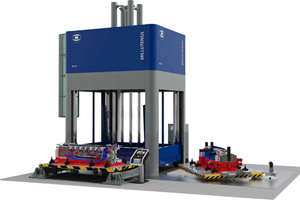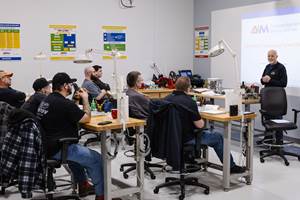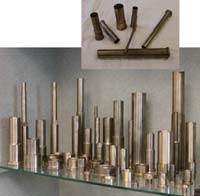Copper Beryllium Vs. Beryllium-Free Copper
Learning the advantages and disadvantages of each alloy coupled with adhering to safety measures can help your shop stay safe.
Both copper beryllium and beryllium-free copper producers are vehement and adamant about why their products are better and safer than the others out there - and between MSDSs, newspaper articles and media hype, separating fact and fiction can be a confusing and time-consuming venture.
Representatives from both sides of the fence weigh in on the pros and cons of each alloy so you can make the right decision about what is best for your shop.
Beryllium - a silver-gray metallic element that occurs naturally in about 30 minerals - is lighter than aluminum yet stiffer than steel. For the moldmaker, this translates into efficient heat conduction and faster cooling. However, this element can be hazardous to your health. According to the Department of Energy (DOE) Training Reference for Beryllium Workers and Managers/Supervisors Participant Manual entitled Communicating Health Risks, Working Safely With Beryllium, the most significant disadvantage of beryllium as an industrial material is the toxicity of its dust, fumes and soluble salts. And, unless ventilation and other controls are used, small particles and chips of insoluble beryllium-containing materials break off during machining and other processes and spread through the air in the work area.
Inhalation of these tiny particles is the type of exposure that can lead to chronic beryllium disease (CBD) - an irreversible and sometimes fatal scarring of the lungs (see Warning Signs of Chronic Beryllium Disease). On the other hand, all of the documented cases of CBD thus far have dealt with the element in its pure form - either as pure beryllium or pure beryllium compounds - and once beryllium is dissolved into copper, beryllium comprises about 1.85 percent of the alloy.
Non-beryllium copper alloys - developed as an alternative to copper beryllium - contain nickel, which also is on the same list of hazardous substances. However, non-beryllium alloy manufacturers point out that nickel is only a carcinogen in fish, and when nickel is machined and ground, the particles do not become airborne, as is the case with beryllium.
So, what is a moldmaker to do when confronted with such a difference of opinion on such a controversial topic? Who is right and who is wrong? How can you be sure that the information out there is accurate? Unfortunately, there is not enough evidence at this time to provide you with the "right" answer - but you can take a closer look at both sides of the story to make a more educated decision.
Copper Beryllium
Nate Gildersleeve, director of technology for NGK Metals Corp. (Reading, PA) - a manufacturer of copper beryllium products - urges people to be cautious when dealing with copper beryllium, but not to panic. "As a rule, anything that is published - particularly by manufacturers of competitive alloys - does not distinguish between handling pure beryllium and something that contains less than one percent of beryllium. People just see that name beryllium and it is dealt with categorically. Even we actually don't make as much discrimination as is deserved between pure beryllium and a beryllium-containing alloy because we want people to treat it with respect.
"The unfortunate effect - based on what's been published and what the competitive material manufacturers put out there - is that respect has been replaced by fear," Gildersleeve continues. "It's very counterproductive for us. This is the heart of the subject, yet it's appropriate to keep people grounded in caution - they shouldn't grind half of the material away and just let it get into the air because there may be one of those unlucky couple percent of people with 'right' allergy that will cause them to contract CBD. We still have to be responsible about it, but we are always looking for an appropriate way to improve people's understanding about what the risks are and where they come from, and what's the magnitude compared to what they are reading about. It's hard to separate from all of this when the word beryllium is in your name."
Carlos Cruz Wilson, a metals specialist for Houston, TX-based National Bronze and Metals, Inc. - a producer and distributor of a range of copper and copper alloys in various forms and shapes - also feels the public outcry over copper beryllium is mainly caused by ignorance. "The health issues, although legitimate, can be controlled with the proper handling of the beryllium alloys, or even the beryllium metal itself," he states. "Only when beryllium-containing materials are ground, sanded, polished, welded, EDM'd or changed - producing a dust, fume or mist - will there be any risk of exposure. Turning, milling and drilling presently create no risk when done wet with the proper coolant.
"Only when these airborne particles are less than 10 microns in diameter are they able to penetrate the air sacs of the lungs, thus causing a high risk situation," Wilson continues. "For beryllium to cause disease, the particles must penetrate the air sacs of the lungs with repeated exposure. The person exposed also needs to be allergic to beryllium to get the disease, and statistics show that only about three to four percent of the population is susceptible to the effects of beryllium."
Wilson adds that beryllium's unique properties "give copper the strength of steel, with the conductivity of a copper alloy," and allow the moldmaker to bring heat energy into the old and dissipate that energy very quickly. "The results are shorter cycle times, which leads to the ability to produce more parts and put more money in your pocket," he affirms.
NGK Metals mandates that first-time buyers of its copper beryllium read the MSDSs and Speaking Out literature that describe the risks of working with the alloy and how these risks are managed. "In a nutshell, if you are set up to safely machine metals, you also can safely machine beryllium copper," Gildersleeve states. "There isn't a lot of dry grinding that goes on out there for making a finished machine part, or the kinds of operations that put fine particles into the air. We do caution moldmakers against torch cutting pieces - to cut into larger pieces they should be using a saw. We make precautionary statements and we are liable and required to put some very stringent warning labels on the material as well to protect against misuse.
"The non equitable facet to this that's always amazed me is that there have been arguments for some time about how to characterize the health hazards of beryllium and what levels are appropriate and so forth; and most of the competitive alloys contain nickel - which has been a known carcinogen for a long time - and there's just no fuss made about that for some reason," Gildersleeve adds. "I mean, it's in your flatware, stainless steel, etc., and the copper alloys that compete with beryllium copper contain higher levels of nickel, but for whatever reason it just doesn't seem to get much attention."
Cliff Moberg, president of Performance Alloys (Germantown, WI) - a supplier of beryllium-free copper alloys for use in constructing cavities, cores and inserts, as well as other applications - refutes the aforementioned statement. "While nickel is a listed carcinogen, the human exposure methods vastly differ for the elements beryllium and nickel," he explains. "The risk to humans with nickel is through ingestion of contaminated fish and seafood caught from nickel-contaminated waters. Those contamination arenas were common in the days of industrial waste dumping prevalent in years past. Additionally, since nickel is a heavy metal, the particles do not become airborne like beryllium," he points out, "and there is no known direct connection to human disease with inhalation of nickel, where there is with beryllium."
Beryllium-Free Copper
According to Moberg, his company's copper nickel alloys possess the same superior strength and conductivity of copper beryllium, if not better. "In addition, we have found that copper beryllium products are sensitive to heat," he comments. "In other words, some copper beryllium alloys lose hardness, tensile and conductivity if it is heated above 600'F, where our product is unaffected to temperatures in excess of 900'F."
Moberg also contends that copper beryllium producers use a number of tactics to steer potential users toward their product and mask the alloy's contents that could be termed questionable. "The most obvious example is that they publish copper beryllium's ultimate properties instead of the average numbers to compare their products," he says. "Our competitors publish their numbers on a higher scale while we publish our nominal numbers - taking their very best properties and publishing them instead of publishing the typical mean (most often attainable) numbers that we do. It would be nice if they would note that they were publishing their ultimate properties. We note in our literature that our numbers are nominal. If you are comparing products, make sure that the information you are looking at is either third-party based or it's objective reporting - not something provided from the producer of the product."
To that statement NGK Metals' Gildersleeve responds, "Among beryllium copper producers, there may be some variations in how the product is presented in promotional literature," he comments. "It appears to me that beryllium copper products are represented nominally, rather than the highest possibility, including promotions published by our direct competition (i.e., beryllium copper producers). For instance, a possible hardness range for one product may be 36 to 42. The median is 39, but the product may be nominally advertised at 40. I do not cry foul against our competitor because their product (and ours) is statistically better represented by 40 than by 38 or 42 after testing hundreds of pieces."
Moberg of Performance Alloys adds that recent independent testing conducted at Western Michigan University proves that beryllium-free alloys perform from a cycle time standpoint about five to seven percent better than any of the beryllium copper alloys that were tested. According to this study - which compared widely used mold steels with beryllium copper and beryllium-free copper alloys and focused on cycle time reduction, quality changes and component performance - the beryllium-free alloy performed seven percent faster than the beryllium copper alloys.
Making a Choice
NGK Metals' Gildersleeve does his best to simplify this complicated issue. "It really boils down to whether the part manufacturer is designing the tool, or a machine shop or subcontractor is designing the tool," he states. "If your job is to make money by making more parts that you can ship at the end of the day, then beryllium copper will give you a way to do that. That is our experience. When we see people designing molds whose primary source of revenue comes from making parts, there's beryllium copper all over their molds. If their primary source of revenue is making molds, beryllium copper is usually relegated to occasional insert materials where just nothing else will work."
As the popular saying goes, "Forewarned is forearmed." Before you make a decision about which alloy to use, educate yourself. Your alloy manufacturers and suppliers have guidelines for safe machining, EDM'ing and polishing. Go to their websites and read the MSDSs. The information is out there and readily available - it is up to you to get your hands on it and absorb it before you can decide what works for your shop. Gildersleeve sums it up quite nicely, "Whether you are using a beryllium-containing alloy or a non-beryllium-containing alloy, don't use either as a license to lower your guard about health and hygiene."
Related Content
ICYMI, MMT Chats: 30 Under 30 Honoree, Plastics Engineering TA Teaches Value of Learning and Producing Not Perfection
MoldMaking Technology Editorial Director Christina Fuges brings on UMass Lowell Plastics Engineering Teaching Assistant Michael Shone as a guest for this MMT Chat to discuss moldmaking through the lens of academia. This episode is brought to you by ISCAR with New Ideas for Machining Intelligently.
Read MoreCertified Quality Management for Plastics Professionals – Materials to Tooling to Recycling
Why is certification of a shop’s quality management system to ISO 9001, AS9100, IATF 16949 or ISO 13485 so special? What does the certification signify? And what supports the paper behind the framed certificate?
Read MoreSpotting Press Facilitates Safe, Productive Adjustment, Inspection and Repair of Molds
Millutensil highlights its specialization in mold and die spotting presses for mold validation, equipped to meet the needs of the operator when accessing or adjusting the mold.
Read MoreMold Maintenance Continues to Matter: Enhanced Training Program in a New Facility
I attended a MoldTrax mold maintenance workshop in 2019 and shared my experiences, and despite changes in ownership, the workshop's remarkable value endures, as discussed in a recent Q&A with the current leadership.
Read MoreRead Next
Design Criteria for Using Copper Alloys in Molds
The extent of copper alloy use, the success of its application and the life of the components are determined by the selected alloy in combination with the design of the application.
Read MoreAre You a Moldmaker Considering 3D Printing? Consider the 3D Printing Workshop at NPE2024
Presentations will cover 3D printing for mold tooling, material innovation, product development, bridge production and full-scale, high-volume additive manufacturing.
Read MoreHow to Use Strategic Planning Tools, Data to Manage the Human Side of Business
Q&A with Marion Wells, MMT EAB member and founder of Human Asset Management.
Read More
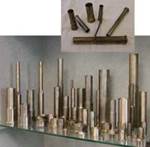


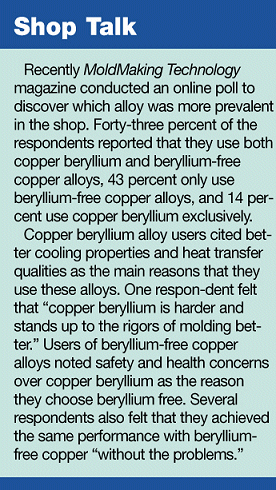
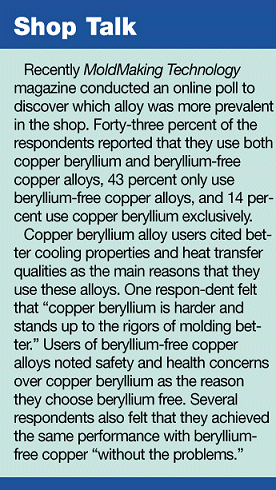





.jpg;maxWidth=300;quality=90)









_300x250 3.png;maxWidth=300;quality=90)




